

Israeli West Bank barrier. The barrier route as of July 2011: 438 km (272 mi) finished, 58 km (36 mi) under construction, 212 km (132 mi) planned.

The barrier in Jerusalem, 2007 Israel argues that the barrier is necessary to protect Israeli civilians from Palestinian terrorism, including the suicide bombing attacks that increased significantly during the Second Intifada.[6] There has been a reduced number of incidents of suicide bombings since the construction of the barrier. According to statistics published by the Israeli government, between 2000 and July 2003, when the "first continuous segment" of the barrier was built, 73 Palestinian suicide bombings were carried out from the West Bank, killing 293 Israelis and injuring over 1,900. However, from August 2003 to the end of 2006, only 12 attacks were carried out, killing 64 Israelis and wounding 445.[7] Supporters argue that this is indicative of the barrier being effective in preventing such attacks.[8] First Intifada. The ensuing Second Intifada took place from September 2000 to 2005.
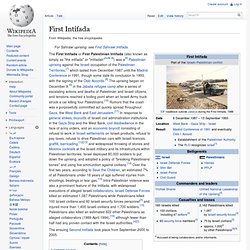
General causes[edit] Palestinians and their supporters regard the Intifada as a protest against Israeli repression including extrajudicial killings, mass detentions, house demolitions and deportations.[17] After Israel's capture of the West Bank, Jerusalem, Sinai Peninsula and Gaza Strip from Jordan and Egypt in the Six-Day War in 1967, frustration grew among Palestinians in the Israeli-occupied territories. Israel opened its labor market to Palestinians in the newly occupied territories.
Palestinians were recruited mainly to do unskilled or semi-skilled labor jobs Israelis did not want. Second Intifada. The Second Intifada, also known as the Al-Aqsa Intifada (Arabic: انتفاضة الأقصى Intifāḍat al-ʾAqṣā; Hebrew: אינתיפאדת אל-אקצה Intifādat El-Aqtzah), was the second Palestinian uprising against Israeli occupation – a period of intensified Israeli-Palestinian violence.

It started in September 2000, when Ariel Sharon made a visit to the Temple Mount, seen by Palestinians as highly provocative; and Palestinian demonstrators, throwing stones at police, were dispersed by the Israeli army with military force, using lethal ammunition.[6] Both parties caused high numbers of casualties among civilians as well as combatants: the Palestinians by numerous bomb attacks and gunfire; the Israelis by tank and gunfire and air attacks, by numerous targeted killings, and by harsh reactions on demonstrations.
1948 Arab–Israeli War. Suez Crisis. Six-Day War. The Six-Day War (Hebrew: מלחמת ששת הימים, Milhemet Sheshet Ha Yamim; Arabic: النكسة, an-Naksah, "The Setback" or حرب ۱۹٦۷, Ḥarb 1967, "War of 1967"), also known as the June War, 1967 Arab–Israeli War, or Third Arab–Israeli War, was fought between June 5 and 10, 1967, by Israel and the neighboring states of Egypt (known at the time as the United Arab Republic), Jordan, and Syria.
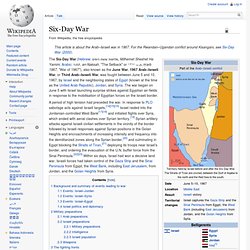
The war began on June 5 with Israel launching surprise strikes against Egyptian air-fields in response to the mobilisation of Egyptian forces on the Israeli border. A period of high tension had preceded the war. Background and summary of events leading to war After the 1956 Suez Crisis, there were numerous minor border clashes between Israel and its Arab neighbors, particularly Syria. On November 4, 1966, the Soviet Union vetoed a six-Power resolution inviting Syria to prevent incidents that constituted a violation of the General Armistice Agreement.[24] Events: Israel–Jordan Events: Israel–Syria Arab preparations.
War of Attrition. The War of Attrition (Arabic: حرب الاستنزاف Ḥarb al-Istinzāf, Hebrew: מלחמת ההתשה Milhemet haHatashah) involved fighting between Israel and Egypt from 1967 to 1970.
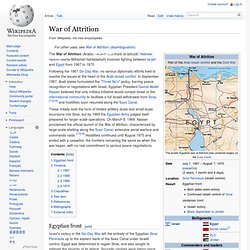
Following the 1967 Six-Day War, no serious diplomatic efforts tried to resolve the issues at the heart of the Arab-Israeli conflict. In September 1967, Arab states formulated the "Three No's" policy, barring peace, recognition or negotiations with Israel. Egyptian President Gamal Abdel Nasser believed that only military initiative would compel Israel or the international community to facilitate a full Israeli withdrawal from Sinai,[17][18] and hostilities soon resumed along the Suez Canal. These initially took the form of limited artillery duels and small-scale incursions into Sinai, but by 1969 the Egyptian Army judged itself prepared for larger-scale operations.
Egyptian front[edit] The international community and both countries attempted to find a diplomatic solution to the conflict. Timeline[edit] Yom Kippur War. The Yom Kippur War, Ramadan War, or October War (Hebrew: מלחמת יום הכיפורים Milẖemet Yom HaKipurim or מלחמת יום כיפור Milẖemet Yom Kipur; Arabic: حرب أكتوبر ḥarb ʾUktōbar, or حرب تشرين ḥarb Tišrīn), also known as the 1973 Arab–Israeli War, was a war fought by the coalition of Arab states led by Egypt and Syria against Israel from October 6 to 25, 1973.
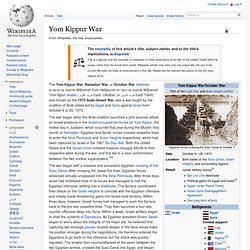
The war began when the Arab coalition launched a joint surprise attack on Israeli positions in the Israeli-occupied territories on Yom Kippur, the holiest day in Judaism, which occurred that year during the Muslim holy month of Ramadan. Egyptian and Syrian forces crossed ceasefire lines to enter the Sinai Peninsula and Golan Heights respectively, which had been captured by Israel in the 1967 Six-Day War. Both the United States and the Soviet Union initiated massive resupply efforts to their respective allies during the war, and this led to a near-confrontation between the two nuclear superpowers.[44] Background According to Chaim Herzog: 1982 Lebanon War. The 1982 Lebanon War (Arabic: الاجتياح, Al-ijtiyāḥ, "the invasion"), (Hebrew: מלחמת לבנון הראשונה, Milhemet Levanon Harishona, "the first Lebanon war"), called Operation Peace for Galilee (Hebrew: מבצע שלום הגליל, or מבצע של"ג Mivtsa Shlom HaGalil or Mivtsa Sheleg) by Israel, and later known in Israel as the Lebanon War and First Lebanon War, began on 6 June 1982, when the Israel Defense Forces invaded southern Lebanon.
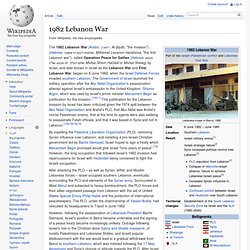
By expelling the Palestine Liberation Organization (PLO), removing Syrian influence over Lebanon, and installing a pro-Israeli Christian government led by Bachir Gemayel, Israel hoped to sign a treaty which Menachem Begin promised would give Israel "forty years of peace".[16] However, the long occupation that followed Israel's 1982 invasion had repercussions for Israel with Hezbollah being conceived to fight the Israeli occupation.
Background[edit] Relocation of PLO from Jordan to South Lebanon[edit] Lebanese Civil War[edit] Incidents 1975–1980[edit] 2006 Lebanon War. Smoke over Haifa, Israel, after a rocket launched by Hezbollah hit the city near Bnei-Zion hospital The conflict was precipitated by Zar'it-Shtula incident, On 12 July 2006, militants from the group Hezbollah fired rockets at Israeli border towns as a diversion for an anti-tank missile attack on two armored Humvees patrolling the Israeli side of the border fence.[36] The ambush left three soldiers dead.
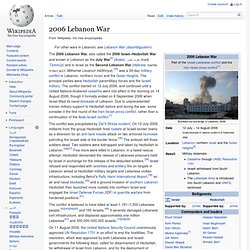
Two soldiers were kidnapped and taken by Hezbollah to Lebanon.[36][37] Five more were killed in Lebanon, in a failed rescue attempt. Hezbollah demanded the release of Lebanese prisoners held by Israel in exchange for the release of the abducted soldiers.[38] Israel refused and responded with airstrikes and artillery fire on targets in Lebanon aimed at Hezbollah military targets and Lebanese civilian infrastructure, including Beirut's Rafic Hariri International Airport,[39] an air and naval blockade,[40] and a ground invasion of southern Lebanon.